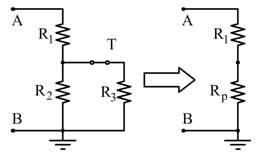Nel caso il tasto T sia aperto, la resistenza R3 è esclusa dal circuito e per andare dal nodo A al nodo B dobbiamo attraversare prima R1 e poi R2. Pertanto, RAB è la serie di R1 con R2:
![]()
Nel caso il tasto T sia chiuso, R2 e R3 sono in parallelo. Si calcola la resistenza equivalente Rp:
![]()
Trovandosi R1 in serie con Rp:
![]()
Ora si vuole trovare il valore della Rx da sostituire a R3 affinché RAB = 96 Ω (con tasto chiuso). Poiché con tasto aperto RAB rimane 100 Ω, analizziamo il caso a tasto chiuso:
![]()
![]()
Il problema diventa algebrico:
![]()
![]()

